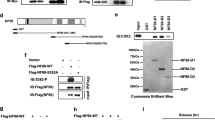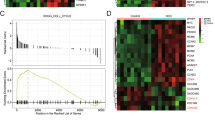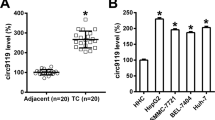Abstract
Activation of cyclin E1, a key regulator of the G1/S cell-cycle transition, has been implicated in many cancers including hepatocellular carcinoma (HCC). Although much is known about the regulation of cyclin E1 expression and stability, its post-transcriptional regulation mechanism remains incompletely understood. Here, we report that nuclear factor 90 (NF90), a double-stranded RNA (dsRNA) binding protein, regulates cyclin E1 in HCC. We demonstrate that NF90 is upregulated in HCC specimens and that suppression of NF90 decreases HCC cell growth and delays G1/S transition. We identified cyclin E1 as a new target of NF90 and found a significant correlation between NF90 and cyclin E1 expression in HCC. The mRNA and protein levels of cyclin E1 were downregulated upon NF90 knockdown. Suppression of NF90 caused a decrease in the half-life of cyclin E1 mRNA, which was rescued by ectopic expression of NF90. Furthermore, NF90 bound to the 3’ untranslated regions (3’UTRs) of cyclin E1 mRNA in vitro and in vivo. Knockdown of NF90 also inhibited tumor growth of HCC cell lines in mouse xenograft model. Moreover, we showed that inhibition of NF90 sensitized HCC cells to the cyclin-dependent kinase 2 (CDK2) inhibitor, roscovitine. Taken together, downregulation of NF90 in HCC cell lines can delay cell-cycle progression, inhibit cell proliferation, and reduce tumorigenic capacity in vivo. These results suggest that NF90 has an important role in HCC pathogenesis and that it can serve as a novel therapeutic target for HCC.
This is a preview of subscription content, access via your institution
Access options
Subscribe to this journal
Receive 50 print issues and online access
$259.00 per year
only $5.18 per issue
Buy this article
- Purchase on Springer Link
- Instant access to full article PDF
Prices may be subject to local taxes which are calculated during checkout








Similar content being viewed by others
References
Duchange N, Pidoux J, Camus E, Sauvaget D . Alternative splicing in the human interleukin enhancer binding factor 3 (ILF3) gene. Gene 2000; 261: 345–353.
Corthesy B, Kao PN . Purification by DNA affinity chromatography of two polypeptides that contact the NF-AT DNA binding site in the interleukin 2 promoter. J Biol Chem 1994; 269: 20682–20690.
Zhu P, Jiang W, Cao L, Yu W, Pei Y, Yang X et al. IL-2 mRNA stabilization upon PMA stimulation is dependent on NF90-Ser647 phosphorylation by protein kinase CbetaI. J Immunol 2010; 185: 5140–5149.
Shim J, Lim H, RY J, Karin M . Nuclear export of NF90 is required for interleukin-2 mRNA stabilization. Mol Cell 2002; 10: 1331–1344.
Pei Y, Zhu P, Dang Y, Wu J, Yang X, Wan B et al. Nuclear export of NF90 to stabilize IL-2 mRNA is mediated by AKT-dependent phosphorylation at Ser647 in response to CD28 costimulation. J Immunol 2008; 180: 222–229.
Shiohama A, Sasaki T, Noda S, Minoshima S, Shimizu N . Nucleolar localization of DGCR8 and identification of eleven DGCR8-associated proteins. Exp Cell Res 2007; 313: 4196–4207.
Ting NS, Kao PN, Chan DW, Lintott LG, Lees-Miller SP . DNA-dependent protein kinase interacts with antigen receptor response element binding proteins NF90 and NF45. J Biol Chem 1998; 273: 2136–2145.
Xu YH, Grabowski GA . Molecular cloning and characterization of a translational inhibitory protein that binds to coding sequences of human acid beta-glucosidase and other mRNAs. Mol Genet Metab 1999; 68: 441–454.
Nanda S, Havert MB, Calderon GM, Thomson M, Jacobson C, Kastner D et al. Hepatic transcriptome analysis of hepatitis C virus infection in chimpanzees defines unique gene expression patterns associated with viral clearance. PLoS ONE 2008; 3: e3442.
Guan D, Altan-Bonnet N, Parrott AM, Arrigo CJ, Li Q, Khaleduzzaman M et al. Nuclear factor 45 (NF45) is a regulatory subunit of complexes with NF90/110 involved in mitotic control. Mol Cell Biol 2008; 28: 4629–4641.
Larcher JC, Gasmi L, Viranaicken W, Edde B, Bernard R, Ginzburg I et al. Ilf3 and NF90 associate with the axonal targeting element of Tau mRNA. FASEB J 2004; 18: 1761–1763.
Vumbaca F, Phoenix KN, Rodriguez-Pinto D, Han DK, Claffey KP . Double-stranded RNA-binding protein regulates vascular endothelial growth factor mRNA stability, translation, and breast cancer angiogenesis. Mol Cell Biol 2008; 28: 772–783.
Bose SK, Sengupta TK, Bandyopadhyay S, Spicer EK . Identification of Ebp1 as a component of cytoplasmic bcl-2 mRNP (messenger ribonucleoprotein particle) complexes. Biochem J 2006; 396: 99–107.
Kuwano Y, Kim HH, Abdelmohsen K, Pullmann R Jr, Martindale JL, Yang X et al. MKP-1 mRNA stabilization and translational control by RNA-binding proteins HuR and NF90. Mol Cell Biol 2008; 28: 4562–4575.
Shi L, Zhao G, Qiu D, Godfrey WR, Vogel H, Rando TA et al. NF90 regulates cell cycle exit and terminal myogenic differentiation by direct binding to the 3'-untranslated region of MyoD and p21WAF1/CIP1 mRNAs. J Biol Chem 2005; 280: 18981–18989.
Kuwano Y, Pullmann R Jr, Marasa BS, Abdelmohsen K, Lee EK, Yang X et al. NF90 selectively represses the translation of target mRNAs bearing an AU-rich signature motif. Nucleic Acids Res 2010; 38: 225–238.
Fung LF, Lo AK, Yuen PW, Liu Y, Wang XH, Tsao SW . Differential gene expression in nasopharyngeal carcinoma cells. Life Sci 2000; 67: 923–936.
Shamanna RA, Hoque M, Pe'ery T, Mathews MB . Induction of p53, p21 and apoptosis by silencing the NF90/NF45 complex in human papilloma virus-transformed cervical carcinoma cells. Oncogene 2013; 32: 5176–5185.
He J, Gu D, Wu X, Reynolds K, Duan X, Yao C et al. Major causes of death among men and women in China. New Engl J Med 2005; 353: 1124–1134.
Lew DJ, Kornbluth S . Regulatory roles of cyclin dependent kinase phosphorylation in cell cycle control. Curr Opin Cell Biol 1996; 8: 795–804.
Keyomarsi K, Pardee AB . Redundant cyclin overexpression and gene amplification in breast cancer cells. Proc Natl Acad Sci USA 1993; 90: 1112–1116.
Sui L, Dong Y, Ohno M, Sugimoto K, Tai Y, Hando T et al. Implication of malignancy and prognosis of p27(kip1), Cyclin E, and Cdk2 expression in epithelial ovarian tumors. Gynecol Oncol 2001; 83: 56–63.
Cam WR, Masaki T, Shiratori TY, Kato N, Okamoto M, Yamaji Y et al. Activation of cyclin E-dependent kinase activity in colorectal cancer. Dig Dis Sci 2001; 46: 2187–2198.
Peng SY, Chou SP, Hsu HC . Association of downregulation of cyclin D1 and of overexpression of cyclin E with p53 mutation, high tumor grade and poor prognosis in hepatocellular carcinoma. J Hepatol 1998; 29: 281–289.
Spruck CH, Won KA, Reed SI . Deregulated cyclin E induces chromosome instability. Nature 1999; 401: 297–300.
Akama Y, Yasui W, Yokozaki H, Kuniyasu H, Kitahara K, Ishikawa T et al. Frequent amplification of the cyclin E gene in human gastric carcinomas. Jpn J Cancer Res 1995; 86: 617–621.
Strohmaier H, Spruck CH, Kaiser P, Won KA, Sangfelt O, Reed SI . Human F-box protein hCdc4 targets cyclin E for proteolysis and is mutated in a breast cancer cell line. Nature 2001; 413: 316–322.
Guo X, Hartley RS . HuR contributes to cyclin E1 deregulation in MCF-7 breast cancer cells. Cancer Res 2006; 66: 7948–7956.
Benson C, White J, De Bono J, O'Donnell A, Raynaud F, Cruickshank C et al. A phase I trial of the selective oral cyclin-dependent kinase inhibitor seliciclib (CYC202; R-Roscovitine), administered twice daily for 7 days every 21 days. Br J Cancer 2007; 96: 29–37.
Guzi T . CYC-202 cyclacel. Curr Opin Invest Drugs 2004; 5: 1311–1318.
Whittaker SR, Te Poele RH, Chan F, Linardopoulos S, Walton MI, Garrett MD et al. The cyclin-dependent kinase inhibitor seliciclib (R-roscovitine; CYC202) decreases the expression of mitotic control genes and prevents entry into mitosis. Cell Cycle 2007; 6: 3114–3131.
Xu B, Zhang K, Huang Y . Lin28 modulates cell growth and associates with a subset of cell cycle regulator mRNAs in mouse embryonic stem cells. RNA 2009; 15: 357–361.
Acknowledgements
This work was supported by the National Key Sci-Tech Special Project of China (2013ZX10002010), and the National Natural Science Foundation of China (31270830). We thank Dr Tilman Schneider-Poetsch, Sarah Head and Yang Xianmei for generously editing the manuscript.
Author information
Authors and Affiliations
Corresponding authors
Ethics declarations
Competing interests
The authors declare no conflict of interest.
Additional information
Supplementary Information accompanies this paper on the Oncogene website
Rights and permissions
About this article
Cite this article
Jiang, W., Huang, H., Ding, L. et al. Regulation of cell cycle of hepatocellular carcinoma by NF90 through modulation of cyclin E1 mRNA stability. Oncogene 34, 4460–4470 (2015). https://doi.org/10.1038/onc.2014.373
Received:
Revised:
Accepted:
Published:
Issue Date:
DOI: https://doi.org/10.1038/onc.2014.373
This article is cited by
-
Characterization of circSCL38A1 as a novel oncogene in bladder cancer via targeting ILF3/TGF-β2 signaling axis
Cell Death & Disease (2023)
-
Circular RNA circCCNB1 inhibits the migration and invasion of nasopharyngeal carcinoma through binding and stabilizing TJP1 mRNA
Science China Life Sciences (2022)
-
Long non-coding RNA ILF3-AS1 facilitates hepatocellular carcinoma progression by stabilizing ILF3 mRNA in an m6A-dependent manner
Human Cell (2021)
-
NF90 stabilizes cyclin E1 mRNA through phosphorylation of NF90-Ser382 by CDK2
Cell Death Discovery (2020)
-
ILF3 is a substrate of SPOP for regulating serine biosynthesis in colorectal cancer
Cell Research (2020)



